Today marks the 75th Anniversary of the fourth day of Operation Argument otherwise known as BIG WEEK. On Wednesday, February 23, 1944 the 15th Air Force went after the Luftwaffe in the skies over Germany — with the 8th Air Force operations grounded by fog — in the battle for air superiority before the Normandy invasion scheduled for June 1944.
Like the previous day, the 15th Air Force lacked fighter escorts.
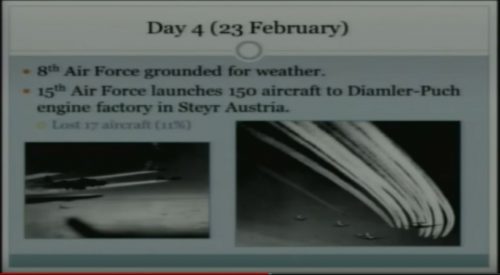
ETO Strategic Operations
Mission 232: 5 of 5 B-17s drop 250 bundles of leaflets on Rennes, Le Mans, Chartres, Lille and Orleans, France at 21:3622:32 hours without loss.
MTO Strategic Operations
B-24s bomb the industrial complex at Steyr, Austria. Other heavy bombers are forced to abort because of bad weather; the bombers and escorting fighters claim 30+ aircraft shot down.
For extensive background, see this Wikipedia article, where the passage above came from:
https://en.wikipedia.org/wiki/Big_Week
From the Pre-War “Conveyor-Protector” to Long Range Escort Fighters
One of the most troubling parts of the US Army Air Force “P-51 Narrative” that the “Bomber Generals” pushed after “Big Week” was that the USAAF had learned nothing from the 1940 “Battle of Britain” about the need for fighter escorts.
It turns out that the US Army Air Corps had not missed that obvious point at all. They utterly got that point. In fact, tab #4 for the AAF’s first Air War Plan (AWPD-1) written in August 1941 called for specialized escort fighters. See this link from Ryan Crierie’s web site —
http://alternatewars.com/WW2/VictoryPlan/Air_Force_Requirements.htm
What they did with that insight was utterly squandered by the factional politics of the “Bomber Mafia” between 1940 and the failure of the second Schweinfurt raid on 14 October 1943.
The need to avoid accountability for that failure — like hiding the real range of the P-47D with 150 gallon drop tanks after “Big Week” — was why this institutional lie was told. The motive being to preserve the reputations of General H. H, “Hap” Arnold and a lot of Bomber Generals who founded the independent US Air Force.
And like any other claims of conspiracy in high places, great claims require great big heaping piles of evidence that they are true. In July 2017 my research partner found the official memorandum chain that constitutes that great big heaping piles of evidence. (See appendices one thru four at the end of this post)
This is how Ryan described this official memorandum chain to me:
I found a memorandum chain in a folder today at NARA titled unconventional escort fighters“, which was full of stuff like the XP-85 Goblin parasite, and a few gems like early consideration of the Northrop XP-79 as a parasite fighter, but at the end of the folder was some stuff circa September 1941 on Long Range Bomber Escort.
.Basically, blah blah, European war experience shows the need for longer range fighters; and it suggested a bunch of studies be done on various heavy bombardment aircraft to turn them into convoy escorts — the beginning of the XB-40/XB-41 program — and they suggested that the B-29 and B-32 be studied as convoy escorts..They also suggested studying aircraft like the XP-67, XP-58, and XA-26 with an interest towards making a fighter with extreme range.
You all can go read the memo chain below, but a short form is as follows —
In the period after both the purging of Claire Chennault’s single engine pursuit (AKA fighter planes) faction in 1937 and and General “Hap” Arnold forbidding auxiliary fuel drop tanks from all USAAF pursuit planes for “safety reasons” in 1939. The leadership of the Army Air Force had a three sided patronage fight over how to get the B-17 to target and how to destroy German multi-engine B-17 analogs.

The first solution pushed was the Bell YFM-1 Airacuda “Bomber Destroyer” As far as I’ve been able to determine, it’s primary high ranking USAAF patrons were Generals Harmon and Kenney of South Pacific fame.
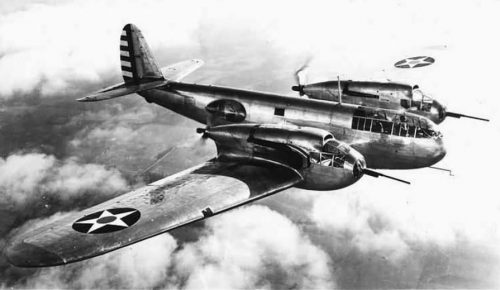
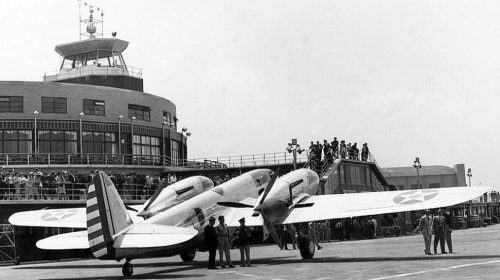
As the Military Factory web site link below makes clear. This plane was an abject failure in both concept and execution.
https://www.militaryfactory.com/aircraft/detail.asp?aircraft_id=662
General Kenney, then head of Material Command and later to serve under General Douglas MacArthur as commander of 5th Air Force, issued in 1940 requirement which turned into the Lockheed XP-58 Chain Lightning as a replacement for the failing Bell YFM-1 Bomber Destroyer. It fared no better than the FM-1. Largely because both Harmon and Kenney were sent to the Pacific in 1942.

As Joe Baugher’s web site put it.
http://www.joebaugher.com/usaf_fighters/p58.html
The Lockheed XP-58 is almost a textbook example of what changing requirements, military mismanagement, and vacillating officialdom can do to a promising military aircraft project. The XP-58 started life as a fairly straightforward development of the P-38 Lightning fighter, evolved in stages into an escort fighter, then into an attack plane, then into a bomber, then into a tank buster, and then finally into a bomber destroyer. These incessant changes in requirements, combined with several changes in powerplants, resulted in the XP-58, which started life in 1940, being delayed until nearly the end of the war.
These failing projects, and the need for an B-17 escort per AWPD-1, lead to the consideration of a “Convoy-Protector” based on the following aircraft:
B-17E
B-29
B-33
B-24E
B-26
B-32
Note that these were all, but for the B-26, 4-engine bombers.
Two of these “Convoy-Protector” bomber-escorts were actually built and one, the B-17 Flying Fortress derivative YB-40, saw combat. And by desperation I mean that it had previously lost the “staffing war” in 1942 to be the preferred solution of the Bomber Generals.
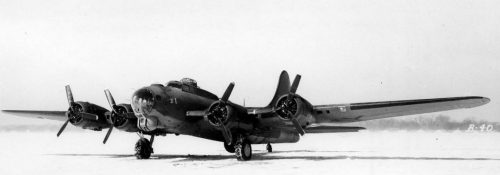
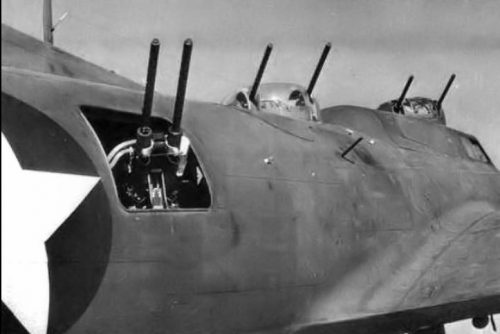
When tried in combat, in a fit of desperation in 1943, the YB-40 failed miserably.
I’ve yet to pin down exactly who other than General “Hap” Arnold supported this concept. Which may have been limited to just the idea of a B-26 “Bomber Escort” after the YB-40 was tried in desperation after the prefered solution failed.
The third, and preferred, solution was the large (300 plus), close formation, self-escorting B-17. It had a far more readily identified high ranking patronage group. They included Generals “Hap” Arnold, Ira C. Eaker, “Tooie” Spaatz among others.
The common thread between both of these “bomber air frame based” solutions was “Magical Thinking.” Like these “Bomber Generals” believed in the Norden bomb sight as the totem that would give them “Precision bombardment.”
They also believed that powered aircraft weapons turrets would ward off enemy fighters. This magical thinking failed to the tune of 26,000 dead in 8th Air Force alone. A this blog post titled “Gunner: An Illustrated History of World War II Aircraft Turrets and Gun Positions” put it:
Turret development in the 1930s showed great promise. New, modern bombers were built with powered turrets installed. The belief was that the bomber with the new turrets could defeat any fighter attack and reach its target. The powered turrets were marvels of technology and design. Fully enclosed, they offered the air gunner double the previous firepower, protection from the elements and increased fields of fire.It was a giant leap forward, but one that was never fully tested. The theory of the self-defending bomber was shattered in combat in early 1939. The turret was not the answer to swift, heavily armed fighters and never would be. The British turned to night bombing to protect their bombers, while the Americans clung to their belief in the self-defending bomber well into 1943.
It was only the arrival of the drop tank using escort fighter, combined with the abandonment of “precision bombing” of a “Choke Point Target” in an “industrial web” in favor using those fighter escorts to kill the Luftwaffe, that the Bomber Generals won air superiority for D-Day.
And they have been lying about it ever since.
-End-
Ryan Crierie’s great big heaping pile of evidence” — The Convoy-Protector” Memorandums
Appendix One – General Kenney’s “Convoy-Protector” 9-31-41 cover letter
NARA II College Park
|
PES:pjd
September 24, 1941
Chief, Materiel Division OCAC, Washington, D.C.
Convoy-Protector Airplane
1. Forwarded herewith is Materiel Division Memorandum Report No. EXP-M-50-582, dated September 17, 1941, in duplicate, setting forth the need for the development of a bombardment convoy-protector type of aircraft and desired Military Characteristics (Exhibit A.)
2. It is requested that the Military Characteristics be submitted to higher authority for approval. These Military Characteristics, if approved, are general enough to cover all types of convoy-protectors required to escort medium, heavy, and long range bombardment aircraft.
5. It is also requested that this office be furnished a directive regarding the development of convoy-protector airplanes for medium and heavy bombardment aircraft. This is not to be confused with the study of convoy-protector airplanes as discussed in CTI-310, dated August 23, 1941, which refers specifically to a long range (10,000 mile) convoy-protector.
F.O. CARROLL,
Lt. Colonel, A.C.,
Chief, Experimental
Engineering Section
I Incl.
MDMR #EXP-M-50-582
(in dup) dated 9-17-41
GEORGE C. KENNEY
Brig. General, U. S. A.,
Ass’t. Chief Materiel Division
NARA II College Park
|
WAR DEPARTMENT
AIR CORPS, MATERIEL DIVISION
MEMORANDUM REPORT ON
PES:pjd
September 17, 1941
SUBJECT: Convoy Protector Airplane
SECTION: Experimental Engineering
SERIAL No. EXP-M-50-582
A. Purpose
1. To set forth the need for the development of a bombardment convoy-protector type of aircraft and to submit military characteristics for approval.
B. Factual Data
1. The most reliable sources of information on the present European War indicate that about 80% of the reasons why bombardment aviation cannot operate by day is its lack of ability to successfully beat-off fighter attacks. This shortcoming has forced upon it the only alternative left; night bombing, which is not nearly so effective as day bombing. Both the British and the Germans have tried to convoy bombardment formations with conventional pursuit fighters, with varying degrees of success, mostly poor, for the following reasons:
a. Because the conventional single seat, fixed front gun fighter does not lend itself readily to convoy work.
b. Because of its limited range the fighter cannot accompany the bomber very far on its mission and, once it has withdrawn, the bomber has no means of protection other than its own armament which is in turn limited because of the design limitations already imposed upon the aircraft by bomb loads, speed requirements and desired range.
2, Bombardment formations offer a certain amount of mutual protection, but only when the fighter does not have a large superiority in numbers. The problems of coping with a combined attack of single seat fixed gun fighters, and multi-seat turreted fighters have not as yet been solved in any manner at all satisfactory.
3. The great daylight raids over London conducted by Germany last fall proved fairly conclusively that bombers, even when escorted by fighters, cannot operate in the face of determined fighter opposition and the present British daylight raids into occupied France do not go beyond the range of their fighters. As German air opposition stiffens, the British losses are mounting and they may again have to abandon daylight raiding, for the time being.
4. It is a well known fact that modern, heavily gunned power turrets in bombers immensely increase their defensive powers, but the quantity and calibre of the armament of modern fighters is also steadily increasing. All of the foregoing may be taken as preliminary to the real purpose of this report, which is to propose what is felt to be at least one effective solution to the problem of protecting daylight bombardment) namely, the bombardment convoy-protector.
5. A brief description of this airplane pictures it as a high-speed multi-engined (probably four) pressure cabin aircraft, carrying a crew of six men, having a high-speed slightly in excess of, and the same range, as that of the bombardment aircraft it is to protect, with engines and personnel armored to a maximum amount, very heavily leak-proofed gas and oil tanks, and fuel and oil lines and with a sufficient number of powerful multi-gunned turrets either locally operated or remotely controlled, or a combination of the two, to enable it to match gun fire with any two modern fighters making simultaneous attacks on it. Such armament for a convoy-protector for medium bombers would normally be of the following order:
a. One upper ‘midships, 50 calibre, four gun turret, operating through 360 degrees azimuth, and from 3 degrees below the horizontal plane of rotation to 85 degrees below same.
b. One lower ‘midships, 50 calibre, four gun turret, operating through 360 degrees azimuth and from 3 degrees above the horizontal plane of rotation to 85 degrees below same.
c. One tail turret of 4 each 50 calibre guns and operating through an included cone of fire of 180 degrees.
d. One 37 MM cannon, or 20 MM cannon in each outboard engine nacelle, semi-flexible and remotely controlled with the following angles of fire: Up 20 degrees, Down 20 degrees, outboard 20 degrees, inboard sufficient for the cannon to intersect fire approximately 100 yards astern of the airplane.
e. Sufficient computer, range finders and remote-control apparatus to efficiently control all machine guns and cannon. The upper and lower turrets should be mounted forward in the fuselage and as close to the plane of propeller rotation as possible to insure adequate forward protection, though it is believed that in this type of aircraft most use will be made of the guns abeam and astern, above and below.
6. Twin tails are desirable since all astern attacks, both of the conventional type and of the newer long range style, delivered by forward firing fixed gun fighters mounting multiple batteries of cannon of the 20 MM or 37 MM variety will make it very desirable to bring to bear all guns astern in very heavy concentrations of fire.
7. The protector type aircraft, because of the nature of its mission, must be able to absorb a great deal of enemy gun fire and still remain in action. Therefore, the need for incorporating in the design extra heavy armor on personnel and vital engine parts and carefully designed and heavily leak-proofed tankage and fuel and oil lines is necessary. Every advantage should be taken in locating equipment so that it, too, will afford protection to the most vital parts.
8. Radio and Navigation equipment should be held to a minimum compatible with the requirements of the mission to be performed. If this type were operating alone, (it would also be an excellent destroyer for patrolling ship lanes at sea on the lookout for hostile bombers) it then would need full navigation equipment and a long range liaison set. This last should be installed as a readily removable piece of equipment and carried an an alternate load, since when operating as a bombardment protector it normally would not under any conditions leave its bomber convoy and should therefore be able to utilize their long range radio facilities, as well as in great part their navigational facilities.
9. It may be that conditions will be found to be such that it is not deemed expedient at this time to proceed with the above design on a high priority status. An alternative is suggested in the conversion of a certain number of some suitable existing type bomber to a stop-gap convoy-protector. Such a conversion would undoubtedly not realize the speed, fire power or range of the type set forth in the attached Military Characteristics, Exhibit A, but it would be close enough to permit a study to be made o such a project. Such a converted bomber probably could not attain either the maximum speed or range of the convoyed bomber but it would be able to afford convoy protection over a large percentage of the missions which the bomber would be called upon to perform and the bombardment could be restricted entirely from those missions beyond the range of this particular type of protector or so arrange its flights that any portion thereof beyond the scope of the protector aircraft would be accomplished under cover of darkness.
10. Taking as an example the Martin XB-33 airplane as a suitable type for conversion into a convoy-protector airplane; the armament would be increased by the addition of two more 50 calibre guns in the tail and a lower 50 calibre, four gun turret to replace the present 50 calibre, two gun turret. There is not sufficient room in the wings or the engine nacelle to mount semi-flexible 37 MM cannon. It is barely possible that one each 20 MM cannon or one each 50 calibre machine gun could be mounted in the outboard engine nacelle. These changes would undoubtedly affect top speed somewhat adversely. Increasing ammunition allowances and armor, plus extra leak-proofing in addition to the above mentioned armament changes, would rapidly equal and surpass the weight allowance gained by leaving out the normal bomb load. To prevent exceeding the maximum allowable gross weight, some fuel would then have to be omitted. The increased leak-proofing of the tanks would probably further reduce fuel capacity, all of which would make it impossible to meet the range of the XB-33 as a bomber.
11. It is not the purpose of this report to propose what tactics would be employed in the use of the convoy-protector, type airplane. As a matter of information, such tactics have never been employed. If all information available is reliable however, it is felt that, in general, such aircraft would probably be used in some combination of the following:
a. Cover the flanks of the formation, abeam, above and below from hostile fighter attacks, staying between the bombardment aircraft and the most concentrated of such attacks.
b. Protect the airplane of the formation leader. A favorite attack of both British and German fighter pilots is to attempt to shoot down this aircraft.
c. Protect the rear of the formation from straight astern attacks and from low angle diving and climbing attacks, as well as from long range attacks directly to the rear.
d. Protect the formation from attacks by multi-place turreted fighters.
e. At the command of the formation leader, shift from place to place within and adjacent to the formation as required.
12. This defensive-fighter type would never leave the formation, or its immediate vicinity, except in isolated cases when the formation is being subjected to a special type of attack which might demand such a maneuver. One of the weaknesses of conventional fighter aircraft when used to protect bombardment is that whenever the bombardment is attacked by hostile pursuit, the fighter must turn to meet the attack of the enemy in order to prevent their reaching the bombers. The moment this is done the protecting fighter loses the formation, since it immediately draws away from the fighter and this leaves the bombers wide open to the attack of any enemy pursuit not otherwise engaged. Because of its completely flexible armament, the convoy-protector would never have to leave the bombardment aircraft formation it was protecting in order to efficiently combat, repel and destroy enemy fighters.
C. Conclusions
1. That a new type of aircraft designated as a bombardment convoy-protector is a requisite for successful daylight bombing operations.
D. Recommendations
1. That the Military Characteristics governing this type, attached herewith as Exhibit A, be approved, and development of one or more experimental articles initiated.
2. That studies be made to explore the possibilities of converting some suitable type bomber into a practical convoy-protector and, if these studies show the project to be worth while, that a conversion be authorized and made.
/S/
P.E. SHANAHAN,
Major, Air Corps
Project Officer
H.Z. BOGERT,
Lt. Colonel, A.C.
Technical Staff
F.O. CARROLL,
Lt. Colonel, A.C.
Chief, Exp. Engr. Section
Central Files
Ch., Mat.Div (1)
Ch.,Mat.Div., Att: Exec. (1)
Ordnance Officer, W.F.
– – – – – – – – – – – – – – – – – – – – – – – – – – – – – – – – – –
M.D.M.R. No. EXP-M-50-582,
Convoy Protector Airplane,
9/17/41
EXHIBIT A
Subject: Military Characteristics of Aircraft.
To: Deputy Chief of Staff for Air.
1. The following principal characteristics of Bombardment Convoy Protector Airplanes are submitted for approval:
CONVOY PROTECTOR AIRPLANE
A. Class – Multi-engine Landplane.
B. Mission – The primary mission of this type of airplane is to escort and protect bombardment aircraft while on bombing missions, by virtue of its superior armament and armor.
C. Requirements –
1. Range – For tactical operation this airplane should have the same radius of action and range as the bombardment aircraft it is to convoy.
2. Speed – High speed shall be the maximum obtainable with relation to the requirements for range and armament. The altitude for maximum speed shall be consistent with the speed and altitude at which bombardment aircraft operate. Speeds approaching 400 miles per hour are envisioned.
3. Flying Characteristics – The landing and take-off characteristics of bombardment aircraft shall prevail. Base of control in flight, take-off and landing is important. The maneuverability shall be slightly in excess of the bombardment aircraft convoyed.
4. Armament –
(a) Guns – The armament of this type of airplane shall consist of the maximum number of machine gun and auto-loading cannon turrets and gun emplacements so located that a maximum concentration of gun fire may be brought to bear on any point in a sphere of 100 yds. radius surrounding the airplane with special emphasis placed on accurate and effective cannon fire through a rear cone of 45 ° included angle. The turrets, gun emplacements and control stations shall be so situated that effective fire power may be concentrated upon all airplanes of a simultaneous three (3) airplane attack made by conventional single seat fixed gun fighters or multi-place turreted fighters or a combination of the two.
(b) Fire Control – Sufficient fire control apparatus to insure efficient operation of the guns and cannon shall be installed.
(c) Bombs – There shall be no provision for carrying bombs in this airplane.
(d) Photographic Equipment – None, with the exception of provisions for gun-sight aiming point cameras.
5. Crew – The crew shall be held to an absolute minimum that will permit efficient performance of the mission for which this airplane is intended.
6. Equipment –
(a) Radio equipment shall be as light and compact as possible and shall be held to that minimum consistent with requirements for the tactical mission. Provisions shall be made for the quick installation or removal of long range liaison radio.
(b) Instrument and navigational equipment shall be the minimum consistent with the requirements for effective day and night operation of the airplane on military missions under all flying weather conditions.
7. Structure and Design Features –
(a) Designs to meet these requirements shall take cognizance of the compromises necessary as a result of technical limitations. Those factors that produce a maximum fire power and passive protection, coupled with high speed maneuverability and range will be the primary considerations in determining the proper compromises.
(b) Pressurized cabins or compartments shall be provided for the efficient functioning of the crew at high altitudes.
2. These characteristics, if approved, will be effective for the development of experimental models for future procurement.
Appendix Three – 12-24-41 Escort Fighter Cross Reference
NARA II College Park
|
Cross Reference No. 452.1 – Fighter, escort, confid
From: Sims, Tech. Ex., TAS:ms
To: Prod. Engr.
Cross Reference from No.: 111.3 – Program Airplane
Date 12-24-41
Subject or Substance of Reference:
“Things to Do”
2. Escort Fighters.
a. Experimental Engineering Section – Study on Escort Fighter version of the B-17, B-24, B-29 and B-32 airplanes. Try and use the same basic airplane structure insofar as possible and substitute additional fire power, active and passive protection for bomb loads.
b. Experimental Engineering Section – Study a long range destroyer type of Escort Fighter with a range of 2000 miles at bomber speeds. It is suggested that the P-58, McDonnell, P-69, P-71 and P-61 and A-26 be studied to determine what would be necessary in these designs to increase their range to 2000 miles. Determine whether this range can be obtained by a modification of an existing project, or whether a new airplane should be started in addition to or in lieu of the above.
CROSS REFERENCE RECORD
Appendix Four — 12-31-41 Wright Field “Escort fighter” letter
NARA II College Park
|
FOC:lmf:50
December 31, 1941
Chief, Technical Staff, Experimental Engineering Section, Wright Field.
Escort Fighters.
1. It is requested that design studies be initiated by the Aircraft Laboratory to determine the possibilities of modifying the following listed airplanes in the priority indicated, for the purpose of providing escort fighter aircraft:
B-17E
B-29
B-33
B-24E
B-26
B-32
2. It is my opinion that if these airplanes can be modified to provide additional armament, armor and ammunition without upsetting the flying characteristics and without major modification of the structure, each of these airplanes could be tactically employed as an escort fighter with the Bombardment airplanes in the next lower range scale; i.e. the B-17 series modified as escort fighters would be tactically employed with the B-25 and B-26 series; the B-24 could probably be used with the B-17. and the B-29, B-32 and B-33 would probably be used with the B-17 and B-24 Bombardment airplanes.
3. It is therefore requested that these design studies be carried out to determine the armament installation, offensive and defensive, which could be installed on the airplanes listed within a reasonable period of time, say one year. It is considered advisable that these studies on the airplanes listed be made around (a) locally controlled power operated turrets for all airplanes; (b) additional studies on the B-29, B-32 and B-33 around the present armament installation. All of these studies should include some armor for vital points in the power plant and fuel systems. It is my belief that all of the above listed airplanes have a sufficient number of guns and cannon for escort fighter purposes, and that these studies should consist principally of increasing the ammunition load and the offensive armament.
4. In making these studies it is believed reasonable to limit the fuel load of the escorting airplanes to give a range of 125% of the range of the accompanied airplane, and the reduction in weight of fuel thus obtained to be used in additional protective measures on the escorting airplane.
F.O. CARROLL,
Lt. Colonel, A. C.
Chief, Experimental
Engineering Section.
The fighters turned out to be more effective when NOT escorting bombers. They were eventually allowed to free lance attacking enemy fighters on the ground and taking off and landing.
When I was very little, I acquired a book that remains very interesting. Unfortunately it was printed in newsprint, it was in the hands of five year old until I was probably about fourteen or so when the tattered remains were tossed. I would really like to see a copy. Again unfortunately, I don’t remember the title and searches haven’t turned the book up.
The book was the sort of thing that would be handed to air cadets in 1941 or 1942. The reason I say that is that the book extolled the virtues of the b17e with detailed diagrams of the defensive firing arcs. Also included were the best approaches for bombing a target to achieve maximum effect and other such useful information as well as descriptions of the various kinds of bombs available in including the possibility of nuclear weapons. On the fighter side, the virtues of the p38 and p39 interception and an overview of the types and some elementary fighter tactics. What was missing was any thought about the need provide escort or coverage for bombers and any thought that the fighters would be used for anything other than engaging enemy bombers.
Again, if anybody had seen a copy of this, I would really like to know. I’ve tried searches and it doesn’t seem to be an official military document, yet the material inside had a lot of things that should have been classified yet, I don’t remember seeing a restricted stamp on the pages of the book. The book may have been published as part of the bomber Mafia’s propaganda campaign, feeding the bomber Mafia’s thinking into young boys so that when they were looking to sign up for the air force, they were already think the way that the bomber mafia wanted them to think. The book was similar to other things that I have seen released by other branches of the army at the same time and frankly somebody in the War department in 1939-41 should have told the various branches to put a sock in it and stop dumping doctrines into the press to push whatever they were pushing. If any German embassy type got their hands on that thing, they probably knew pretty much how the AAF was going to approach the war.
I’ve updated this post with a copy of General H.H. “Hap” Arnold May 1939 “Drop tanks, Drop dead” letter regards the use of drop tanks on tactical aircraft.
Note that this order included not only single engine fighters, but also the A-20 twin engine light bombers.